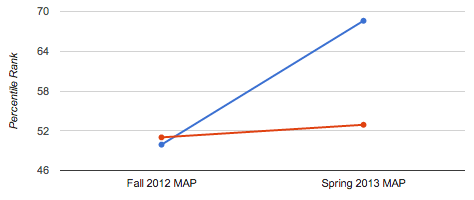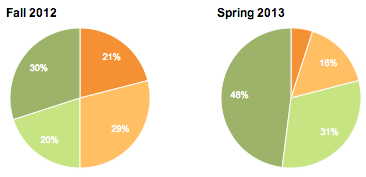
Program Overview
During the 2012-2013 school year, 322 grade 2 students from 6 Charlottesville City Schools (VA) had access to Reflex in their math program. The study compared fall and spring Measures of Academic Performance (MAP) test results of high-usage students — those with at least 40 days of Reflex usage between test administrations — to students with low or no usage (0-5 days) during the same time period.
The Northwest Evaluation Association (NWEA) MAP Mathematics test is a nationally-normed, computer-adaptive assessment used in many U.S. school districts. By administering the test multiple times during a school year, educators can gain a detailed picture of each student's current mathematical level and measure student growth over time. Because the test is nationally-normed, they can also compare their students' growth to that of students across the country.
Student Growth Comparison

Fall 2012 MAP Math test results indicated starting average scores for both groups fell near the national median. The high-usage group ranked in the 49.9th percentile, while the low-usage group ranked in the 51st percentile.
By the 2013 spring administration, results for the two groups had clearly separated. The high-usage group had advanced to the 68.6th percentile, an increase of 18.7 percentile points, while the low-usage group remained near the national median, increasing 1.9 points to the 52.9th percentile.

High Usage Group Percentile Growth

High-usage group students at both the low and high ends of national percentile ranks showed strong improvements.
The percentage of high-usage students in the lowest quartile declined from 21% to just 5%, and those in the lower half went from 50% to 21%. At the other end of the spectrum, the fraction of students in the top quartile increased from 30% to 48%.

Sign up to get the latest updates from ExploreLearning via occasional email.